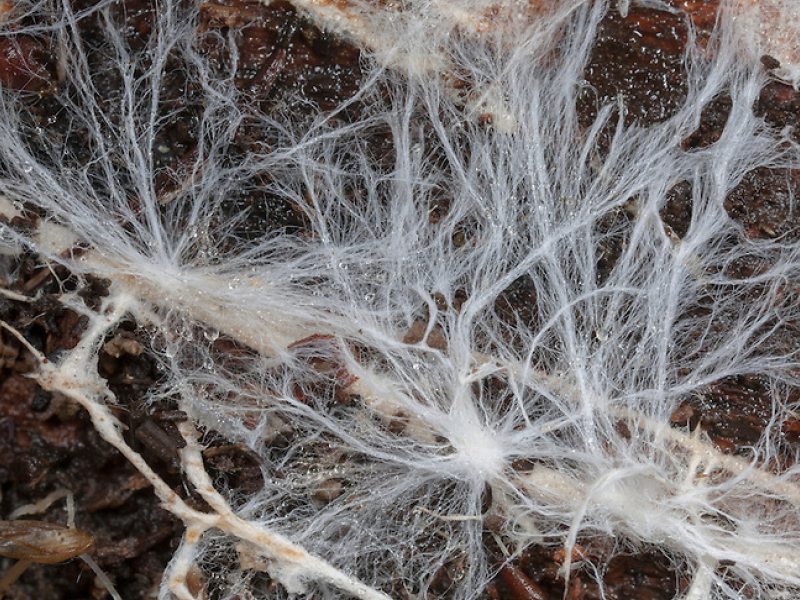What is fungus?
The soil that our lawns grow in contains lots of different types of fungus. Fungus plays an important role in the health of your lawn. It helps to break down dead organic matter and release nutrients into the soil, which is then used by the grass plants.


Fungus is a living organism. It lives, eats and reproduces. The body of the fungus is called hypha (see image above). The hyphae look like plant roots and play a similar role—they absorb nutrients from their surroundings.
Unlike other lawn enemies, fungus can be both a friend and an enemy of the grass plant. For fungus to be a friend, it needs to work in harmony with the grass plants. Therefore, fungal management plays an important role in caring for your lawn.
The soil that our lawns grow in contains lots of different types of fungus. Fungus plays an important role in the health of your lawn. It helps to break down dead organic matter and release nutrients into the soil, which is then used by the grass plants.
Fungus is a living organism. It lives, eats and reproduces. The body of the fungus is called hypha (see image above). The hyphae look like plant roots and play a similar role—they absorb nutrients from their surroundings.
Unlike other lawn enemies, fungus can be both a friend and an enemy of the grass plant. For fungus to be a friend, it needs to work in harmony with the grass plants. Therefore, fungal management plays an important role in caring for your lawn.
How does fungus become a problem?
Fungi can be categorised in several different ways. One way is to categorise them by the way in which they like to absorb their food. One type of fungus absorbs their food from dead organic material, whilst the other prefers to absorb their nutrients from living tissue.
The hyphae (a collection of hyphae is called mycelium), can cause a problem if the amount within the soil grows to excess. Mycelium prevents water from freely moving around the soil due to something called hydrophobia. It is therefore important to ensure that the level of different fungi does not become too much for the soil to handle. These types of fungi are the types that eat the dead organic material in the soil.
Problems associated with these types of fungi are also called soil borne fungi.
What are the most common problems caused by soil-borne fungi?
The most common problems caused by soil borne fungi are:
- Fairy rings
- Localised compaction
What is a fungal disease?
Another type of fungi that we sometimes see in our lawns is a disease-causing fungi, otherwise known as a pathogenic fungi. These types of fungi are the ones that feed on living tissue and require a host (something to live on or in).
An example of a pathogenic fungal disease that feeds on human tissue (on our bodies) is a fungal nail infection. This infection starts to feed on the living nails of human beings, absorbing the nutrients from our nails. The fungal disease will not affect any other parts of our body, but it can make our nails look awful! These types of fungi are difficult to control without correct treatment.
Similarly, in a lawn, a fungal disease lives off the tissue of the grass plant. The disease literally eats its way through the grass plants’ leaves, absorbing all the nutrients as it goes. Most lawn fungal diseases only attack the leaves of the plant, and will never actually kill the entire plant, but just like a fungal nail infection, it can make the plants look terrible.
What lawn fungal diseases are there in the UK?
Do mushrooms in my lawn mean that it's got a fungal disease?
Fungi reproduce through several different methods. One of these methods is through mushrooms. Mushrooms are referred to as the fruiting body of some types of fungi. However, having mushrooms in your lawn does not necessarily mean that fungal diseases are present. For more information, click here.
How do I manage the level of fungi and fungal diseases in my lawn?
Fungus prefers a moisture-rich environment. Ensuring that your lawn is scarified, aerated and overseeded on an annual basis will help to manage the level of fungi and fungal diseases in your lawn, whilst simultaneously improving its overall condition.
In cases where fungus becomes a significant problem, we have the option of applying a fungicide treatment. This will help treat the fungal problem that is present at the time of treatment, but will not prevent recurrence.
